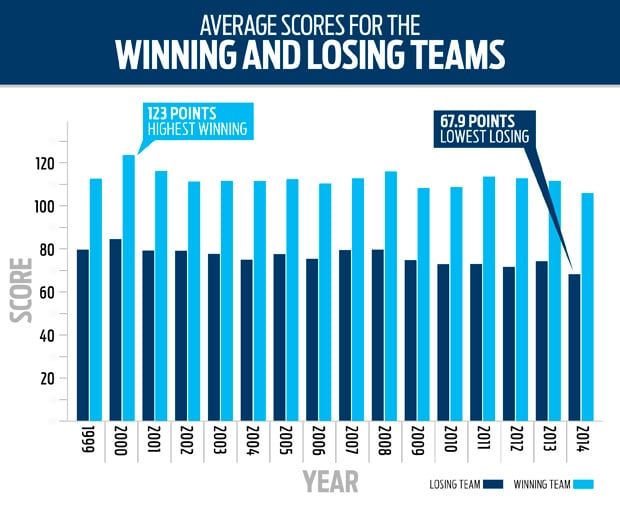NO LESS than twenty times this season has a team gone into half-time with 20 points or fewer on the scoreboard.
It began in the opening half of the first game of the season, when Collingwood posted just 2.8 to half-time against Fremantle.
That was lower than the Magpies' first-half score in round one, 1897.
The game that ended 2014's shootout drought
When North Melbourne played the Western Bulldogs in round two, neither side managed to reach the meagre total of 20 points at the long break, a figure that is about par at that stage of a game for most under-10 teams.
And the same thing has happened at least once, but more often twice, in every round since - except round eight.
It's not just confined to the strugglers either.
Eleven teams, from last year's grand finalists Fremantle, to the bottom of the ladder Brisbane Lions, are part of the list.
Remember, Fremantle had just 12 points on the board at half-time in last year's Grand Final.
So entrenched is the trend that it has continued right up until the final game of round 10 when Adelaide scored just 19 points to half-time against Carlton.
Unbelievably, the Crows went into the break only seven points down.
Such an ugly look on the half-time scoreboard represents a massive change on what spectators (and players) are used to seeing.
Only six times did a team go into half-time with 20 points or less on the board in the first 81 games of 2013, a figure similar to the first 80 games played in 2009 (7/80) and 2005 (8/80).
It’s a massive drop from the 2000 season, where the average winning score was 123 points and the average losing score was 84.2. In that year, just eight times in 176 games did a team fail to score 20 points in the first half.
Port Adelaide defensive coach Matthew Nicks, who was playing for the Sydney Swans back in 2000, says it's obvious nearly every team is better defensively nowadays.
But to him, it's more a changed mindset combined with the physical capability to run hard both ways that makes teams able to restrict their opposition better than they did in the past.
He points out rightfully that teams still play very attacking football at times and that such things as putting numbers behind the ball have been happening for a long time.
"I think the biggest thing is the mental shift for a lot of teams," Nicks told AFL.com.au
"We've always looked at our games as 'oh well goals are scored that just happens' but I think a lot of teams now have begun to look at it with a soccer mentality and in soccer a goal against is just deadly… you can be scored against and that can be the end of the game. I know a number of clubs now are looking at it that way so the mindset of players now is we don't want to be scored [against]."
It's a fascinating reflection of what impact the increased professionalism and globalisation of the game can have on the way it is played.
Nicks said Port Adelaide – which is second for points for and equal third best defensive record in 2014 – had an offensive and defensive coaching method, which involved every player on the list in each aspect.
His responsibility as defensive coach is to deliver the messages on what to do when the team does not have the football. This is a shift from the days when the backline coach was responsible for the back six and a few understudy defenders.
A sharp football brain such as the one Nicks' possesses can identify possible reasons why scoring is down, but determining whether the game is better or worse as a spectacle because of lack of scoring is a tougher ask.
"It's a tough one. I've watched games that have been low scoring that have been just fantastic games of footy," Nicks said.


